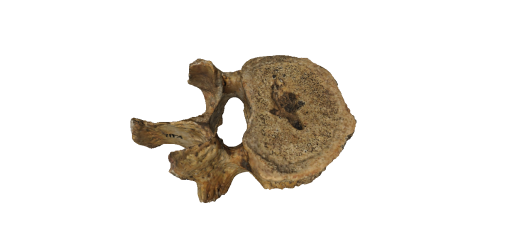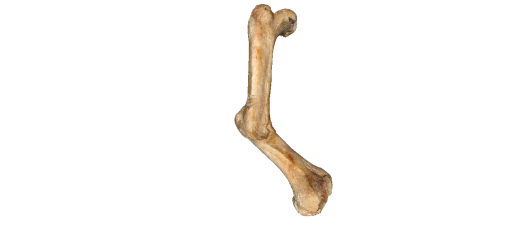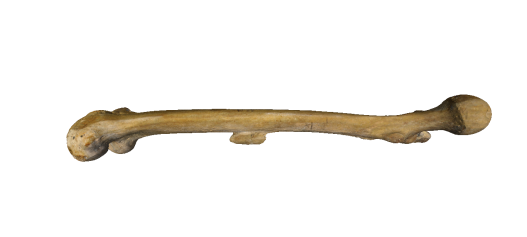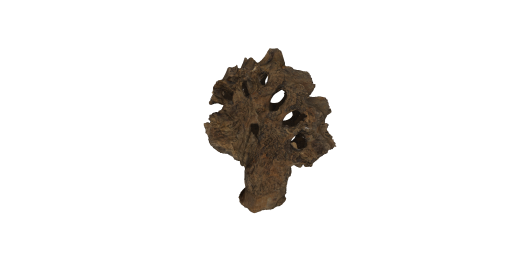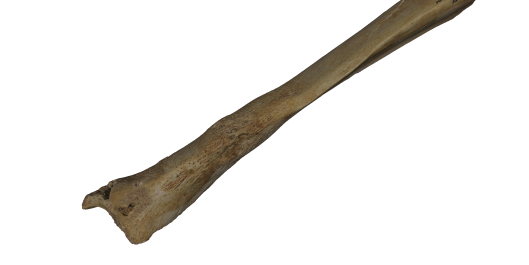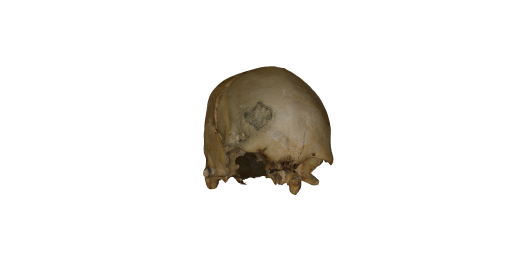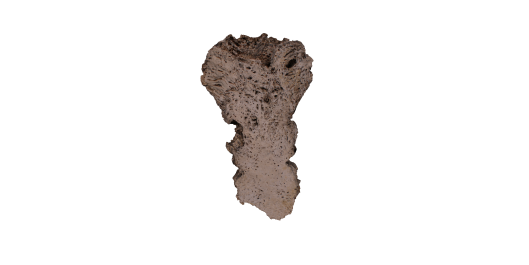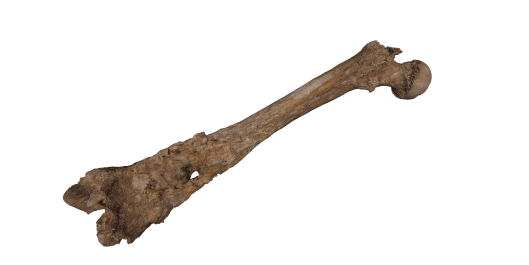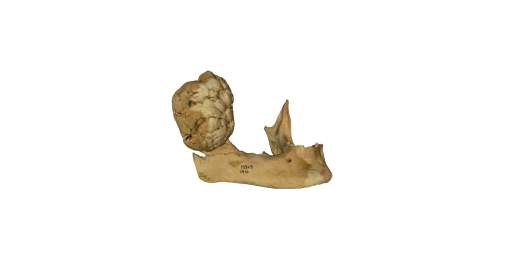
Mandible
There is a large lobulated mass of compact bone on the right ascending ramus. The mass measures c. 56.4mm superoinferior x 42.1mm anteroposterior x 30mm mediolateral. The medial surface of the assenting ramis is heavily pitted.
Co-existing Pathology:
Teeth lost ante-mortem: LL3,5,6: LR4,5,6; Teeth lost post-mortem: LL1,2,3,4,7,8: LR 1,2,3,4,,7,8. Lower left 7 and LR7 have severe mesial tilt indicating LL6 and LR6 had been lost when individual aged 12 -18 years.
Disease Classification:
Neoplastic-benign-osteoma
Miscellaneous-dental-ante-mortem tooth loss
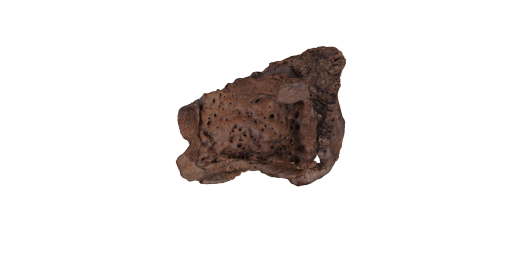
Right maxilla
This is a posterior fragment of the right maxilla. There is a layer of new compact bone, which is nodular, on the visible surfaces with extensive pitting (the pits being large in size).
Disease Classification:
Infective-non-specific-maxillary sinusitis
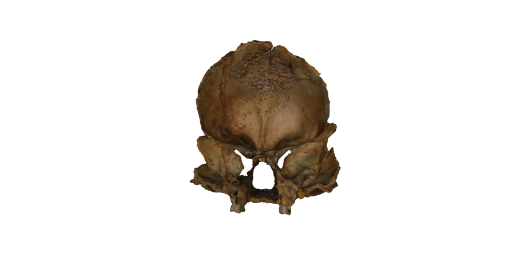
Frontal and maxillae
Orbits- There is a diffuse convoluted mixture of bone destruction, new compact bone formation and expansion of the diploic channels on the right orbital roof and on an area of the greater wing of the sphenoid superiorly. The left orbit is covered in remodelled smooth new compact bone with areas of bone erosion and expansion of the diploic channels giving a convoluted appearance.
Maxillae- There is new compact bone on the nasal floor that has a vascular pattern and extensive porosity near the right infra-orbital foramen. There is extensive pitting of the anterior quarter of the palate.
Zygoma- There is slight pitting and bone erosion bilaterally.
Sphenoid-There is mild pitting to the external surface of the right greater wing.
Frontal- There is a large area of bone destruction on the endocranial surface of the frontal. This lesion is located centrally on the superior and anterior surface. There is expansion of the diploic channels transversely and perpendicular expansion of trabeculae through the endocortical surface centrally and superiorly within the lesion, with convoluted areas of cortical bone anteriorly and laterally.
Disease Classification:
Metabolic-deficiency-anaemia
Miscellaneous-skeletal-cribra orbitalia
Miscellaneous-skeletal-endocranial lesions
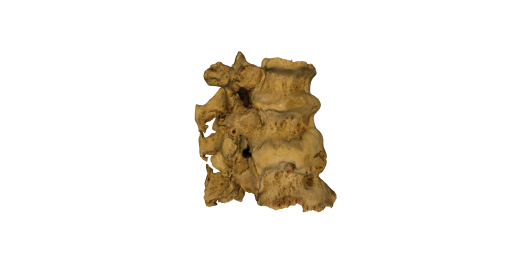
Tenth to twelfth thoracic vertebrae and a partial left tenth rib
The tenth to twelfth thoracic vertebrae are fused though a flowing ossification of the anterior longitudinal ligament, which becomes a more irregular ossification on the right side on the twelfth thoracic vertebra and on the left side of the tenth to twelfth thoracic vertebrae. This flowing ossification also extends to and fuses the left tenth rib to the vertebral body of tenth thoracic vertebra, which is broken post-mortem. An extension of bone from twelfth thoracic to first lumbar vertebrae creates a pseudo-articulation. The intervertebral disc spaced is preserved. There is a flowing ossification of ligaments from below the transverse process of eleventh thoracic, over the joint, to just superior to the right inferior facet of the twelfth thoracic vertebra.
The vertebrae would have had continuous fusion from the second to tenth thoracic vertebrae. However, it is broken post-mortem into three separate pieces.
Co-existing Pathology:
Osteophytosis is visible on the exposed vertebral body margins, which in many places can be observed to be overlapped by the flowing ossification of the anterior longitudinal ligament.
Other pathological changes include variations in the surface contour of the laminae of most of the vertebrae; all costal facets have osteophytic lipping and joint surface contour changes; partial ossification of the supraspinous ligament from tenth to twelfth thoracic vertebrae, with fusion between tenth and eleventh thoracics; surface pitting on the exposed superior surface of fifth thoracic vertebra; and a nodule and an irregular plaque of new compact bone anterior to the posterior margin of the inferior surface of the body of ninth thoracic vertebra.
When are articulated, the vertebral column shows kyphosis and left scoliosis—with an apex of curvature at the fourth and fifth thoracic vertebrae—and abnormal lordosis in the lower lumbar.
Disease Classification:
Miscellaneous-skeletal-diffuse idiopathic skeletal hyperostosis
Miscellaneous-skeletal-enthesophytes
Degenerative joint disease-osteoarthritis
Degenerative joint disease-osteophytosis
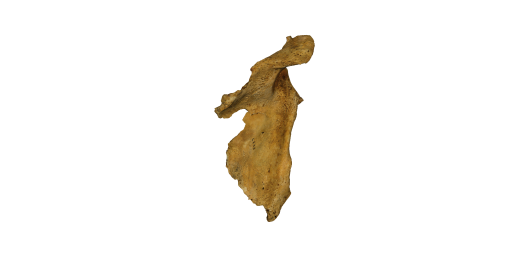
Scapula
The majority of this bone is covered in multiple fine osteolytic lesions and a layer of coarse woven bone, sparing only areas of the blade and glenoid fossa. Taphonomic damage obscures the extent of the new bone formation; it is likely to have been more extensive.
The lesions presented here are the result of metastatic carcinoma of the prostate. However, there is a mixture of pathological lesions distributed throughout the skeleton that are consistent with the individual having co-existing metastatic carcinoma and leprosy. Elements of the lower limb that have leprous lesions or a mixture of lesions from both diseases have been omitted from this project to prevent confusion. Metastatic carcinoma of the prostate is characterised by osteosclerotic lesions and deposition of periosteal new bone (Ortner et al 1991).
References Cited:
Ortner DJ, Manchester K, Lee F. 1991. Metastatic carcinoma in a leper skeleton from a medieval cemetery in Chichester, England. International Journal of Osteoarchaeology 1: 91-98.
Disease Classification:
Neoplastic-malignant-metastatic-metastatic carcinoma
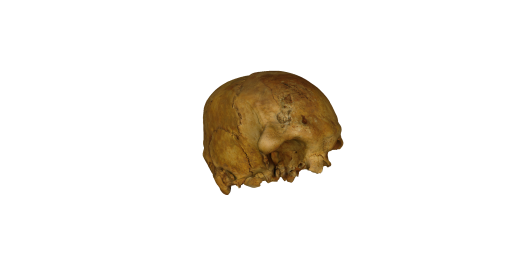
Cranium
Multiple ectocranial osteoblastic lesions are located across the cranium, focused mainly on the frontal and occipital. The majority of these bony protrusions are smooth and contiguous with the original/normal cortical surface. However, two located on the occipital are partially lobulated in appearance, with defined inferior margins. The frontal has at least five lesions: one on the right zygomatic process, one on the right temporal line, one adjacent to the left temporal line, one inferior to glabella on the left side, and one adjacent to the coronal suture on the right side. Here, the largest protrusion is on the right supraorbital margin/zygomatic process and measures c. 19.2mm mediolateral x 24.4mm superoinferior. Two protrusions are visible on the right and one on the left parietal adjacent to the lambdoid suture. The occipital has at least seven large protrusions, five occurring centrally along sutra mendosa, the largest being c.25mm in diameter, and two adjacent to the lambdoidal suture. In this same area on the left side is a cluster of very small irregular nodules of bone.
The diagnosis of this pathology remains uncertain. Ortner (203, 521-524) present a similar case, which is diagnosed as fibro-osseous tumours. These tumours are benign and slow growing.
Co-existing Pathology:
Bilaterally are central areas of joint surface destruction on the articular tubercles of the tempomandibular joint (the left side is partially obscured by taphonomic damage).
References Cited:
Ortner DJ. 2003. Identification of pathological conditions in human skeletal remains. London: Academic Press.
Disease Classification:
Developmental-dysplastic-fibro-osseous tumours


